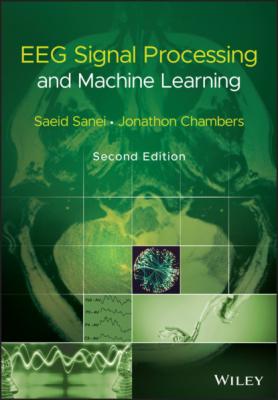EEG Signal Processing and Machine Learning. Saeid Sanei
Читать онлайн.| Название | EEG Signal Processing and Machine Learning |
|---|---|
| Автор произведения | Saeid Sanei |
| Жанр | Программы |
| Серия | |
| Издательство | Программы |
| Год выпуска | 0 |
| isbn | 9781119386933 |
Figure 4.4 shows the TF representation of an EEG segment during the evolution from preictal to ictal and to postictal stages. In Figure 4.4 the effect of time resolution has been illustrated using a Hanning windows of different durations of one and two seconds. Importantly, in Figure 4.4 the drift in frequency during the ictal period is observed clearly.
4.5.1 Wavelet Transform
The wavelet transform (WT) is another alternative for TF analysis. There is already a well established literature detailing the WT such as [16, 17]. Unlike the STFT, the TF kernel for the WT‐based method can better localize the signal components in TF space. This efficiently exploits the dependency between time and frequency components. Therefore, the main objective of introducing the WT by Morlet [16] was likely to have a coherence time proportional to the sampling period. To proceed, consider the context of a continuous time signal.
4.5.1.1 Continuous Wavelet Transform
The Morlet–Grossmann definition of the continuous WT for a 1D signal f(t) is:
where (.)* denotes the complex conjugate,
(4.21)
and
(4.22)
The last property makes the WT very suitable for analyzing hierarchical structures. It is similar to a mathematical microscope with properties that do not depend on the magnification. Consider a function W(a,b) which is the WT of a given function f(t). It has been shown [18, 19] that f(t) can be recovered according to:
Figure 4.4 TF representation of an epileptic waveform in (a) for different time resolutions using the Hanning window of (b) 1 ms, and (c) 2 ms duration.
(4.23)
where
(4.24)
Although often it is considered that ψ(t) = ϕ(t), other alternatives for ϕ(t) may enhance certain features for some specific applications [20]. The reconstruction of f(t) is subject to having Cϕ defined (admissibility condition). The case ψ(t) = ϕ(t) implies
4.5.1.2 Examples of Continuous Wavelets
Different waveforms/wavelets/kernels have been defined for the continuous WTs. The most popular ones are given below.
Morlet's wavelet is a complex waveform defined as:
(4.25)
This wavelet may be decomposed into its constituent real and imaginary parts as:
(4.26)
(4.27)
where b0 is a constant, and it is considered that b0 > 0 to satisfy the admissibility condition. Figure 4.5 shows respectively the real and imaginary parts.
The Mexican hat defined by Murenzi [17] is:
(4.28)
which is the second derivative of a Gaussian waveform (see Figure 4.6).
4.5.1.3 Discrete‐Time Wavelet Transform
In order to process digital signals a discrete approximation of the wavelet coefficients is required. The discrete wavelet transform (DWT) can be derived in accordance with the sampling theorem if we process a frequency band‐limited signal.
The continuous form of the WT may be discretized with some simple considerations on the modification of the wavelet pattern by dilation. Since generally the wavelet function
Figure 4.5 Morlet's wavelet: real and imaginary parts shown respectively in (a) and (b).
Figure 4.6 Mexican hat wavelet.
A Fourier space may be used to compute the transform scale‐by‐scale. The number of elements for a scale can be reduced if the frequency bandwidth is also reduced. This requires a band‐limited wavelet. The decomposition proposed by Littlewood and Paley [21] provides a very nice illustration of the reduction of elements scale‐by‐scale. This decomposition is based on an iterative dichotomy of the frequency band. The associated wavelet is well localized in Fourier space where it allows a reasonable analysis to be made although not in the original space. The search for a discrete transform, which is well localized in both spaces leads to multiresolution analysis.
4.5.1.4 Multiresolution Analysis
Multiresolution analysis results from the embedded subsets
